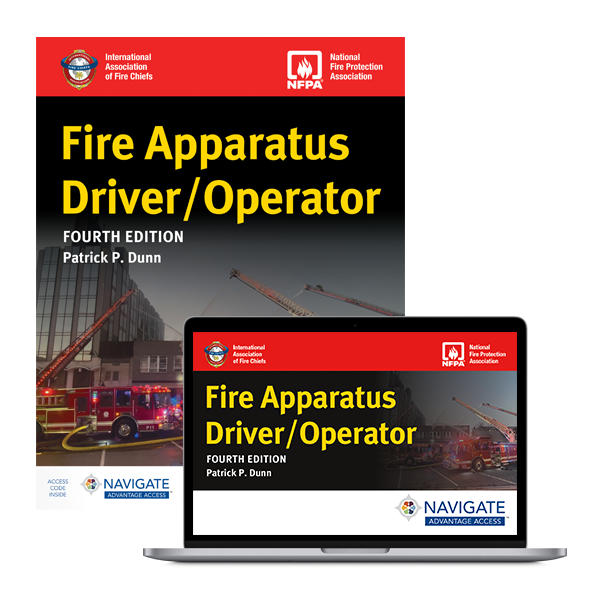Steering Towards Safety: The Critical Role of Driver/Operator Training in Firefighting

In the dynamic world of firefighting, the role of a driver/operator is a crucial, yet often overlooked one. The driver/operator's responsibilities extend beyond just driving the fire apparatus; they include ensuring the operational readiness of the equipment, making split-second decisions during emergencies, and providing consistent, reliable support to their firefighting team.
How the Driver/Operator Role Has Shifted
“Years ago, there was a highly focused component that the driver really knew the mechanics of the apparatus,” said Pat Dunn, an F16 mechanic in the military, nine-year captain of the Kansas City Fire Department, and author of Fire Apparatus Driver/Operator with Navigate Advantage Access, Fourth Edition
But, Dunn notes, with the creation of the automatic nozzle in the 1960s, “eventually we became more focused on the firefighting aspect, and we probably lost a little bit of that mechanical background of what the rig was doing. The automatic nozzle really took away a lot of the understanding of hydraulics.”
Dunn says that as departments transition away from the automatic nozzle, there is a growing need to understand hydraulics. “That importance of that driver knowing what to do and how to troubleshoot is coming back into the forefront.”
The Mechanical Knowledge Gap
There is a growing concern in the fire industry: the decline in mechanical knowledge among driver/operators. In an interview with Public Safety Group, publisher of Fire Apparatus Driver/Operator with Navigate Advantage Access, Fourth Edition, Dunn notes that this decline has led to a disconnect between firefighters and the apparatus they operate. "Years ago, the driver really knew the mechanics of the apparatus. They did a lot of the maintenance on their own," Dunn states, emphasizing the need to revive this essential skill set.
Addressing Staffing Issues in Firehouses
Another pressing issue is the inconsistency in staffing, which Dunn believes leads to a loss of intimate knowledge of the apparatus. "Staffing is affecting everyone in the fire service, and that's not helping with our consistency.”
“In some departments, the driver is an actual position, and the driver drives the apparatus every single day. Other departments, it’s a continuous revolving door of who the operator is for the day. That intimate familiarity with the rig isn’t there," he explains, highlighting the importance of having dedicated operators to maintain efficiency and safety.
High-Rise Firefighting: A Shift in Tactics
Dunn's insights extend to high-rise firefighting, where he describes a shift in tactics that involves driver/operators more directly in standpipe operations on the fire floor. This change allows for more precise pressure adjustments and a more effective response to these complex situations.
Aligning Fire Training and Education with Standards
Aligning training with NFPA 1010 standards is crucial, according to Dunn. He believes in going beyond the minimum requirements to suit the specific needs of each department and jurisdiction. “It's a framework... it's always good to go beyond and suit things to the needs of your department and jurisdiction,” Dunn asserts.
Importance of Training
Firefighting is unpredictable, and often crews must step in where they may not excel. “In our line of work, it is critical that everyone knows at least a good idea of what the person above them is doing in the rank structure,” Dunn said. “Things happen. We operate in a world of emergency operations. In the military, that lead guy gets taken out, and everyone needs to bump up.”
Dunn believes it is essential for all firefighters, regardless of their current role or future aspirations, to be trained as a driver/operator. "It helps with teamwork. It helps with a little bit of compassion instead of becoming a little critical of each other.” Driver/operator training equips firefighters with the skills and perspective necessary to enhance their performance, unity, and resilience in the face of adversity.
Visual Learning and Updated Hydraulics
In Fire Apparatus Driver/Operator with Navigate Advantage Access, Fourth Edition, Pat Dunn uses the power of visual learning, a method that has proven to be highly effective in enhancing the comprehension and retention of complex concepts. By incorporating new images and skill drills into his book, Dunn provides visual learners with the tools they need to grasp the intricacies of firefighting equipment and tactics.
"We can show them the what, but when we really get further in depth on more detailed topics, it is easier to explain and get people to understand when I can include photographs," Dunn said. “Students wouldn't know about hydraulic systems, so we have to show those different things, because otherwise all they know is the one apparatus that's sitting in front of them.”
Rebuilding the Coefficient Chart
Dunn's update to the traditional coefficient chart for hose lines represents a significant advancement in the training of firefighters. This revised chart offers students closer approximations to real-world fireground experiences, bridging the gap between theoretical knowledge and practical application.
"We really tried to focus on building that table to correspond with actual laboratory or actual fireground experience," says Dunn, underscoring the importance of accurate hydraulic calculations in preparing firefighters for the challenges they will face on the job. Dunn worked with Dennis LeGear, one of the leading experts in the field of hose and coefficients, to rebuild the traditional coefficient chart.
Driver/operator training is an indispensable aspect of a firefighter's education that extends beyond personal skill enhancement to fortify the entire team's effectiveness in emergencies. This comprehensive approach to training is what ultimately weaves the fabric of a resilient and proficient firefighting force, ready to face the unpredictable challenges of their critical profession.
Fire Apparatus Driver/Operator with Navigate Advantage Access Fourth Edition
Fire Apparatus Driver/Operator, Fourth Edition is a complete print and digital training solution that addresses pump operation, safe driving techniques, tiller and aerial apparatus operation, and water supply considerations.
Instructors: Request More Information